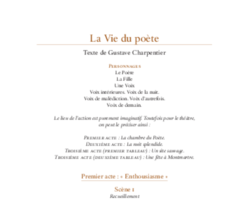La Vie du poète
Enthousiasme – Doute – Impuissance – Ivresse
Charpentier composed La Vie du poète in 1888-1889, when he was at the Villa Medici. He himself wrote the libretto for this ambitious “Symphonie-drame”, which called for several solo voices, chorus and orchestra and lasted about an hour. It is very possible that Charpentier was casting himself in the figure of the poet, embodied successively by a soprano (Enthousiasme), tenor (Doute) and baritone (Impuissance). At the first performance of the work at the Paris Conservatoire, on 18 May 1892, conducted by Édouard Colonne, the critics could not resist comparing it to Berlioz’s Symphonie fantastique. They also praised the mastery of the vocal and instrumental writing, the balance between the chorus and orchestra, the sheer force of the fast movements and the dreamy poetry of Doute. The last section, Ivresse, aroused reservations, as could be seen by the review in L’Art musical: “The action takes place in Montmartre, at the Moulin de la Galette, where the morally flawed poet has gone to forget himself in the midst of strident carnival noise: there, everything squeals, jangles, hammers and shouts; it is hideously realistic.” The composer’s style is particularly original and personal in this movement. He “dreams of grandiose operas, whose poetry and music simultaneously fill his head” (Arthur Pougin in Le Ménestrel). In Rome, Charpentier was actually beginning work on Louise, unaware that he would later draw inspiration from the dramatic sequence of La Vie du poète for Julien (1913) and would reuse the titles of the movements of this Symphonie-drame for the acts of that opera.


